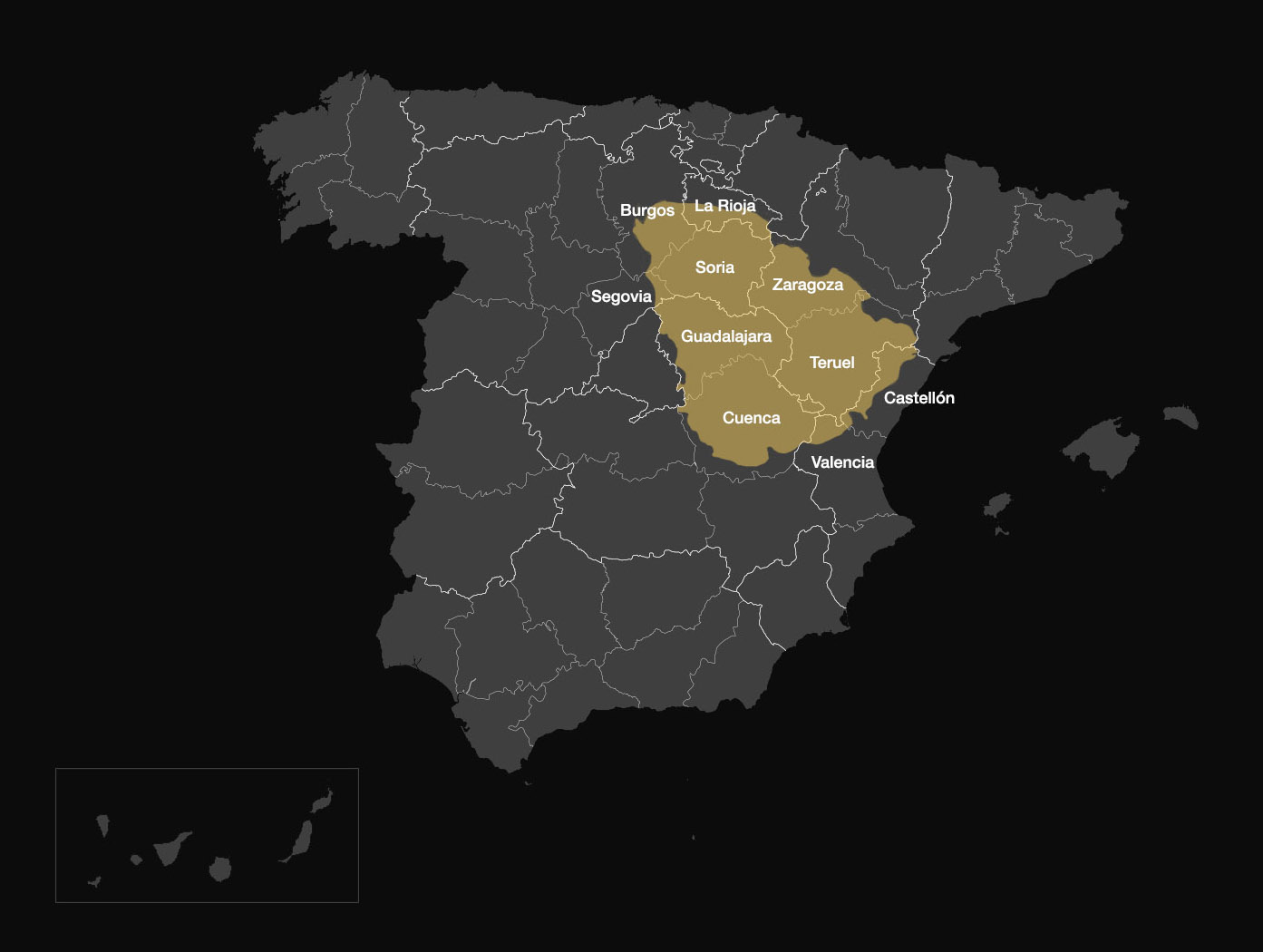Spanish Lapland
Photographs through the Serranía Celtibérica, the largest demographic desert in southern Europe
##IIFFsondaHay bales stacked in a field near the town of Calderuela, in the province of Soria. © Santi Palacios for Sonda Internacional
Project summary
#IIFFsondaMega Fires: Beyond Extinction
This project seeks to illustrate the circumstances surrounding the mega fires devastating Spain by generating a central guide to this phenomenon, presenting the new fire behavior and explaining its consequences on the land and the people. It will also compile the strategies for combating and living alongside them; unearth how ecosystems recover and utilize them; and share the solution projects mitigating their proliferation. As always, the project will tell these stories through photo, video and graphic resources as the main tool. Because seeing is essential to understanding.
Conversations #01: What is a mega fire?
Spanish Lapland
Fuelling a Mega Fire
Facing Fire
‘Lumes’ by Adra Pallón
Join our crowdfunding!
Take the opportunity to directly support in-depth journalism on the climate crisis
Donate
31 May 2023
If we gave a square meter to each human being, the entire population of the planet would fit in an area equivalent to the Community of Madrid.
There are more than 8 billion people in the world. That figure, divided by the land area (about 150 million square kilometers, excluding aquatic areas), results in just over 53 people per square kilometer.
Are we too many or too few?
In places like Macao (China) there are more than 20,000 inhabitants per km2; at the opposite extreme, in countries like Mongolia or Australia the average is 2 and 3 inhabitants, respectively. But these numbers are national averages, large-scale data that doesn’t reflect the differences between territories.
In Spain, the average density is 94 inhabitants per km2. The population of the peninsula is especially concentrated on the coasts and in the large cities on the plateau, and a complex demographic process has been exacerbating this trend for decades.
Not far from the most populated square kilometer of the European Union (which is in the city of Hospitalet de Llobregat, southwest of Barcelona, and home to 50,000 people) is one of the largest demographic deserts in Europe: the Serranía Celtibérica, also known as Southern Lapland or Spanish Lapland due to a similar density of population with the Scandinavian region of the same name.
Serranía Celtibérica covers the lands of five autonomous communities and ten of their provinces: Burgos, Castellón, Cuenca, Guadalajara, La Rioja, Segovia, Soria, Teruel, Valencia and Zaragoza. It extends over 65,489 km2, twice the size of Belgium, and is home to only about 460,000 people in 1,311 municipalities. The average population density is less than 8 inhabitants per km2.
This essay is a tour through the vast territory of Serranía Celtibérica: a journey in photographs of a territory steeped in history. Always at night, when the absence of light pollution allows us to see what isn’t always visible.
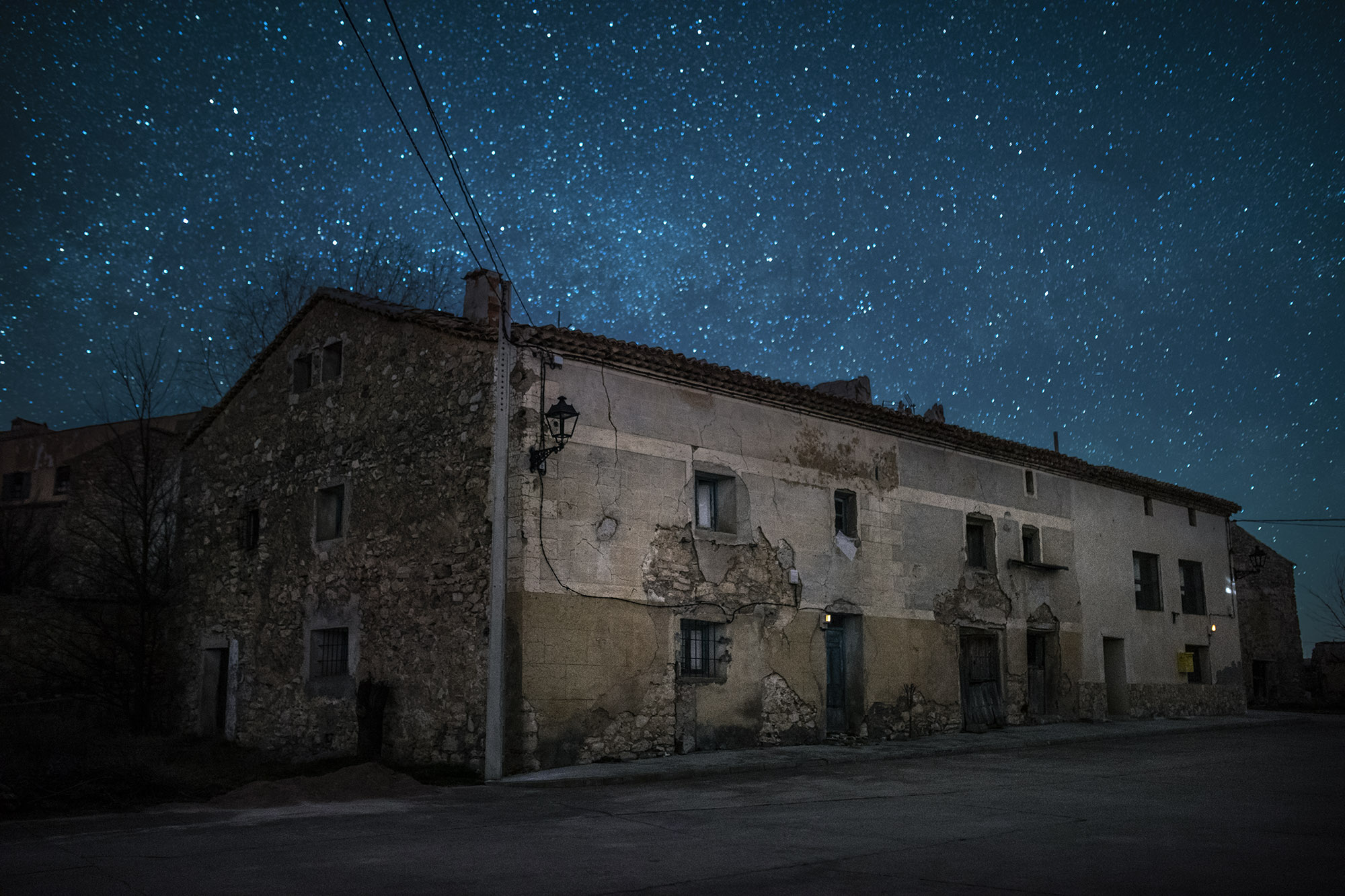
Town of Castilnuevo, in the province of Guadalajara. Although there are residential homes and a visitor’s house, no one lives permanently in the urban centre of the town. © Santi Palacios for Sonda Internacional
The term Southern Lapland or Spanish Lapland was coined in 2012, when expert, Pilar Burillo, identified the inter region of the Serranía Celtibérica as a territory with less than 8 inhabitants per km2: the formal indicator used by the European Union to identify “very sparsely populated areas”. Up until then, the only territory identified with this parameter was the Scandinavian region of Lapland, according to Francisco Burillo, professor of Prehistory at the University of Zaragoza and promoter of the Serranía Celtibérica Project. Subsequently, this low population density has also been identified in the region known as the Celtic Strip.
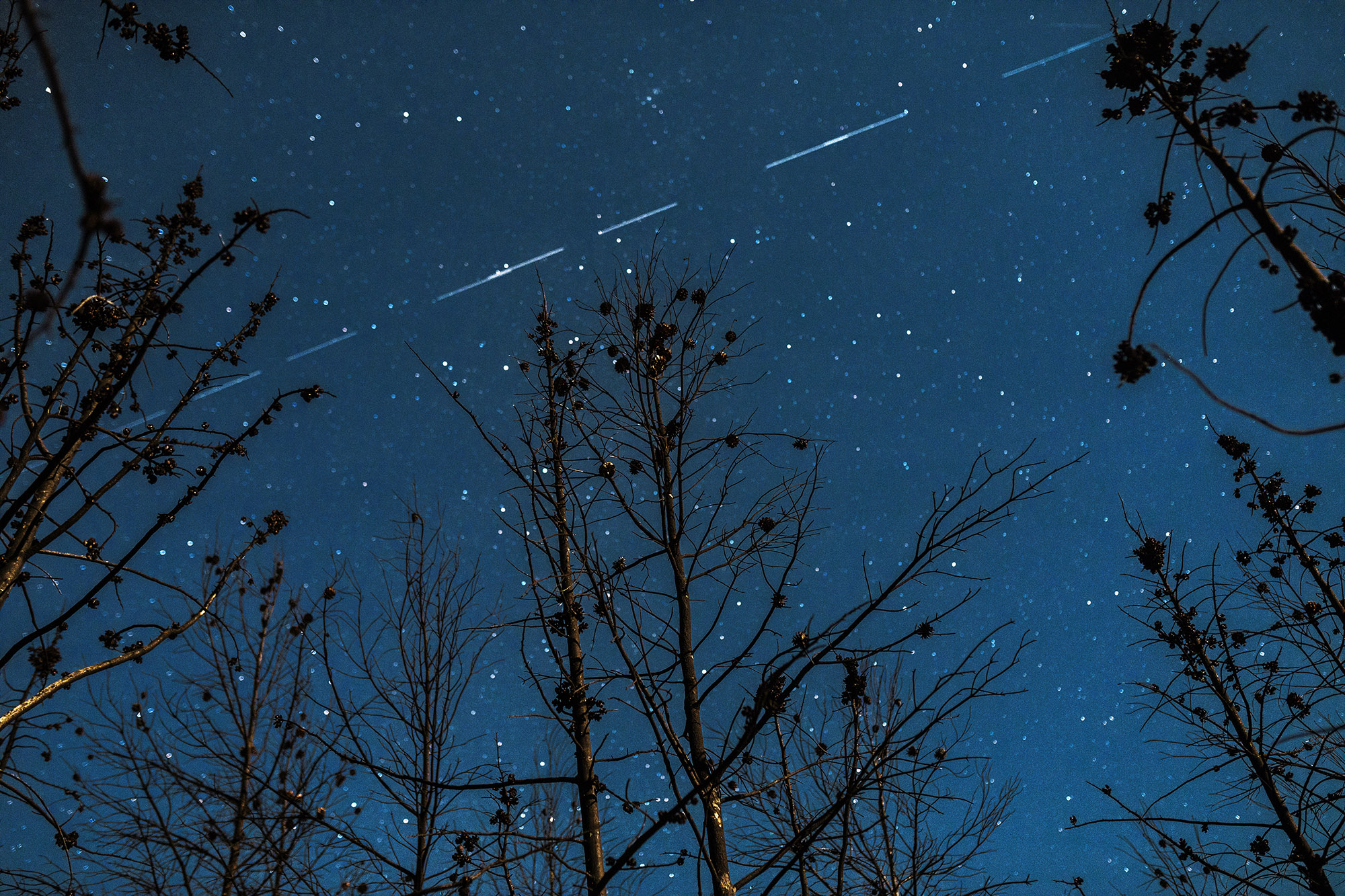
In the image: a constellation of internet satellites, from the company Starlink, seen from a forest burned by Spain’s second largest fire of 2022: it occurred in Bejís, within the province of Castellón, and devastated almost 20,000 hectares.
Sonda Internacional has focused on depopulation within the project ‘Mega Fires: Beyond Extinction’, as experts consider rural abandonment as one of the main risk factors for forest fires.
Here the nuance is important: the key is in the abandonment. This leads to a growth in forest mass, mainly in the form of scrub vegetation, which not only acts as fire fuel but dilutes traditional territorial boundaries: like the mosaic landscape in which the mix of croplands, forests, villages and pastures were erected as fire defenses.
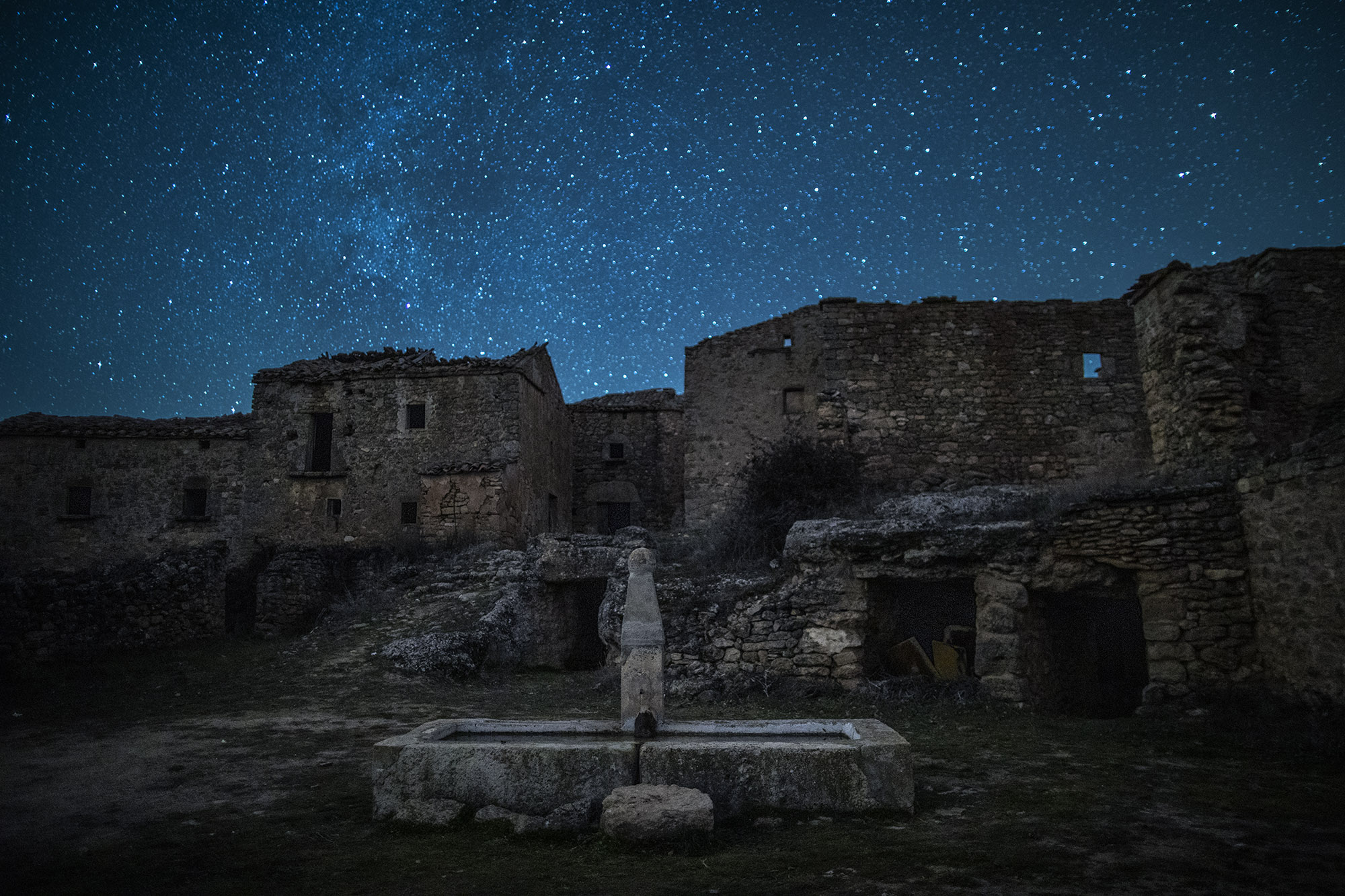
Tobes is an abandoned medieval town within the municipality of Sienes, in the province of Guadalajara. Its last inhabitants left at the beginning of the 1970s. Now there is a project for its restoration.
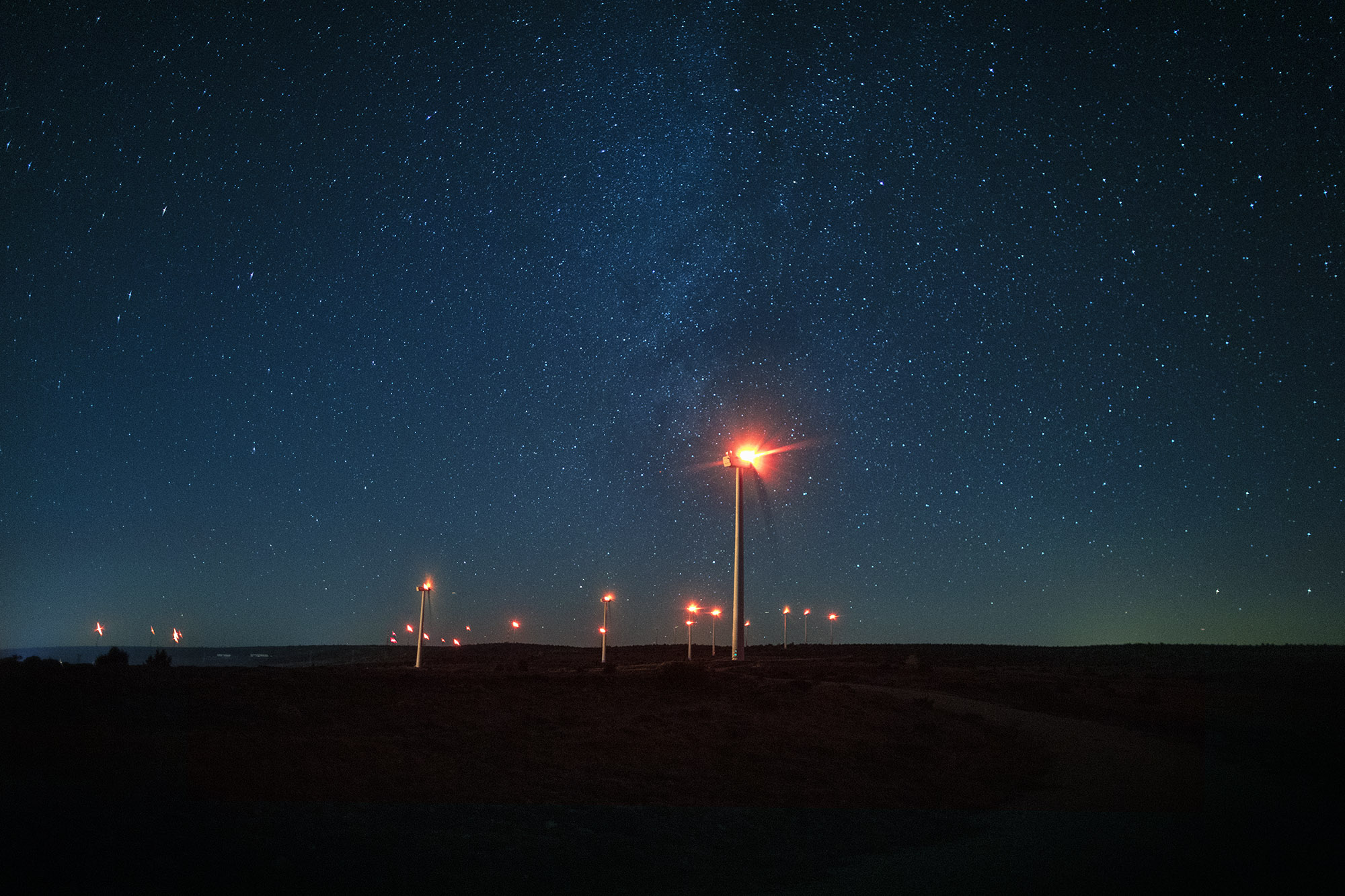
The Maranchón wind farm, in the province of Guadalajara. Windmills and solar panels are part of the current landscape of the Serranía Celtibérica.
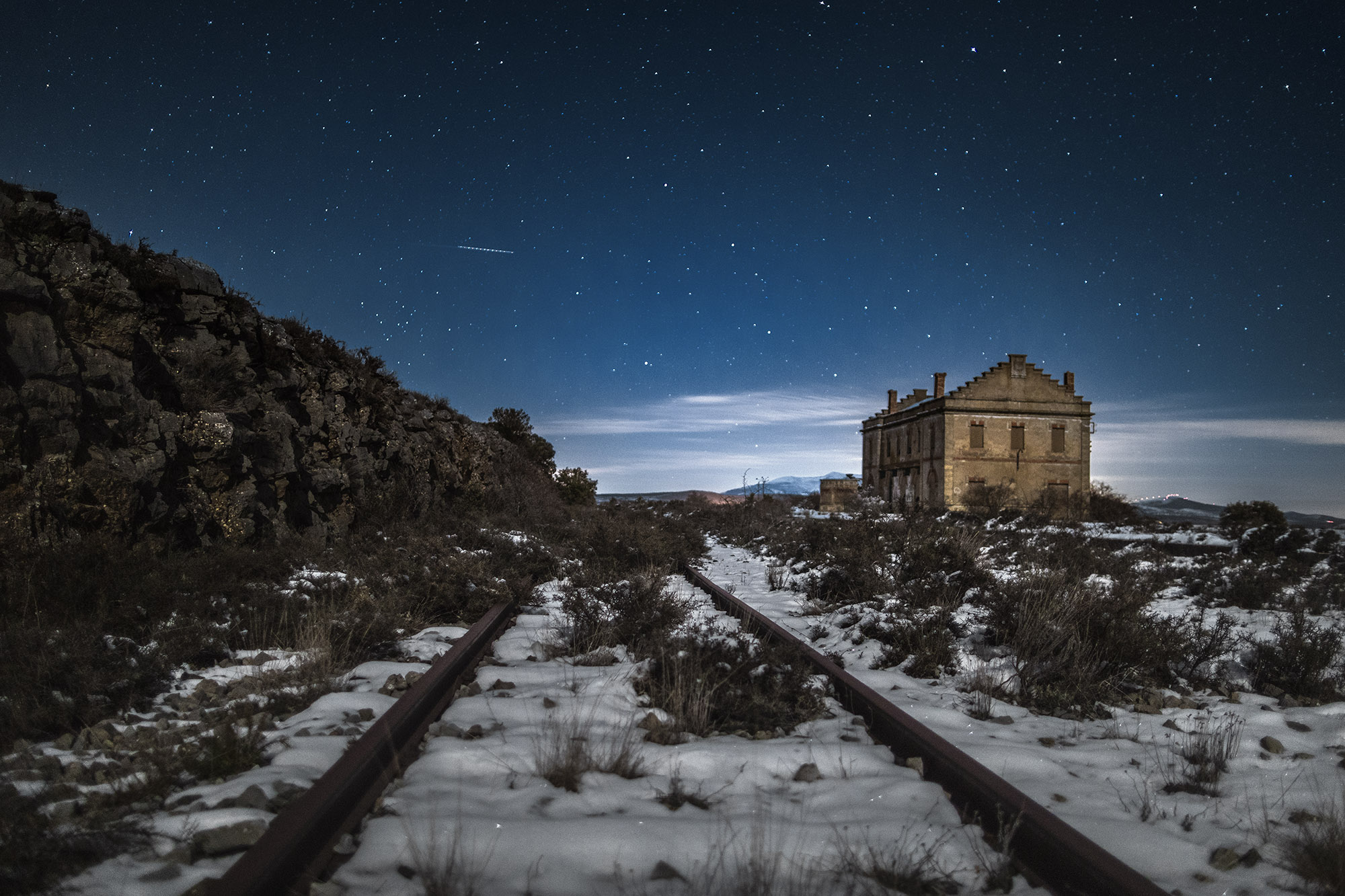
A train station in the municipality of Aldealpozo, in the province of Soria. It belonged to the Soria-Castejón railway line, which was inaugurated in 1941 and in service until 1996. © Santi Palacios for Sonda Internacional
“The lower the population density, the lower the provision of fundamental public services,” says Pascual Rubio, professor of Geography and Territorial Planning at the University of Zaragoza. The fewer the inhabitants, “the greater the distance in terms of minutes to access the nearest high-speed rail line, or the nearest motorway or highway. And the endowment of many private services, such as commercial ones, is also normally less.” These deficits limit the quality of life for rural populations and make the territory less attractive as a place of permanent residence.
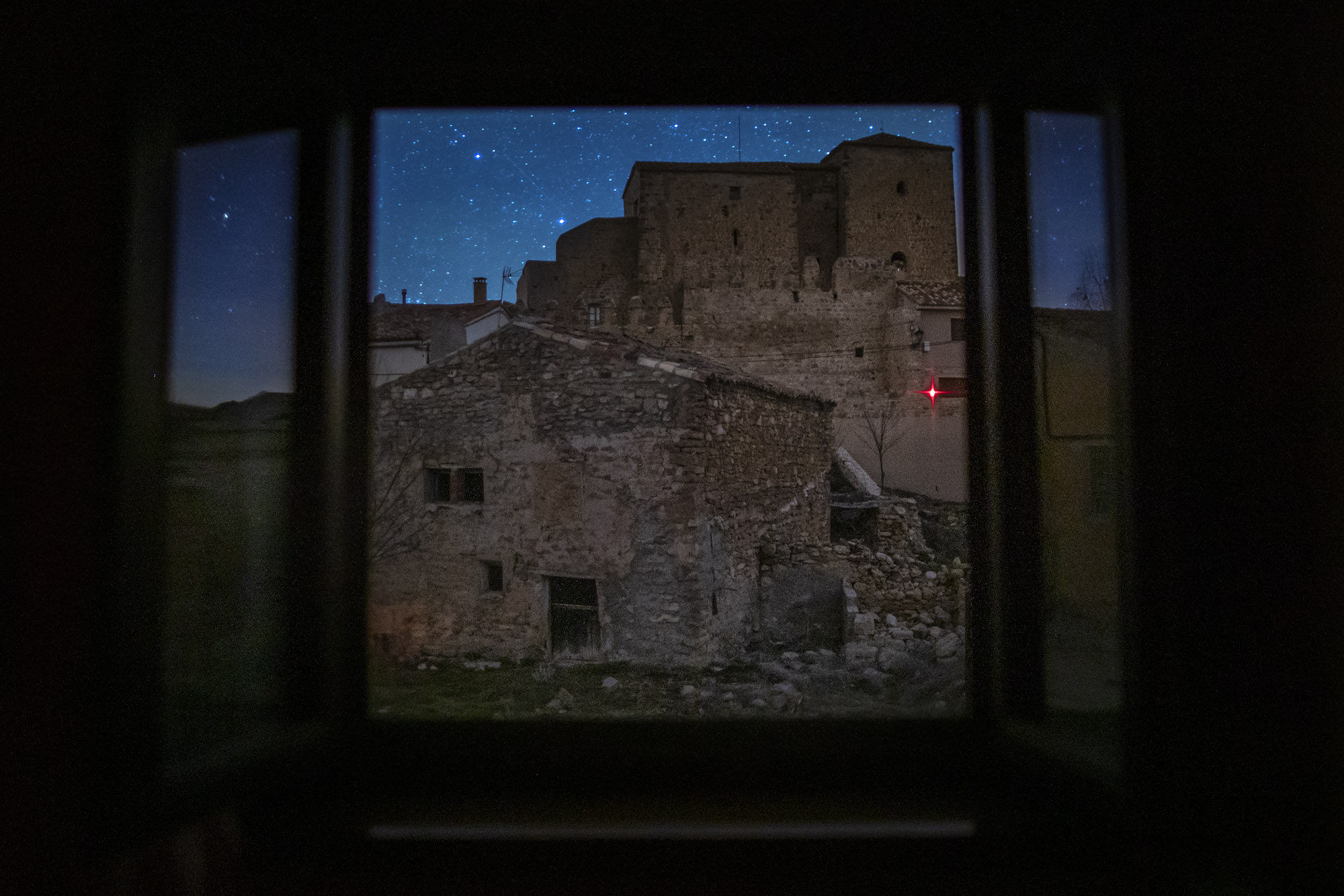
Town of Castilnuevo, in the province of Guadalajara. © Santi Palacios for Sonda Internacional
There are many towns in the Serranía Celtibérica that have become places of second residences. In some cases, it is this which makes it possible for some basic services to be maintained.
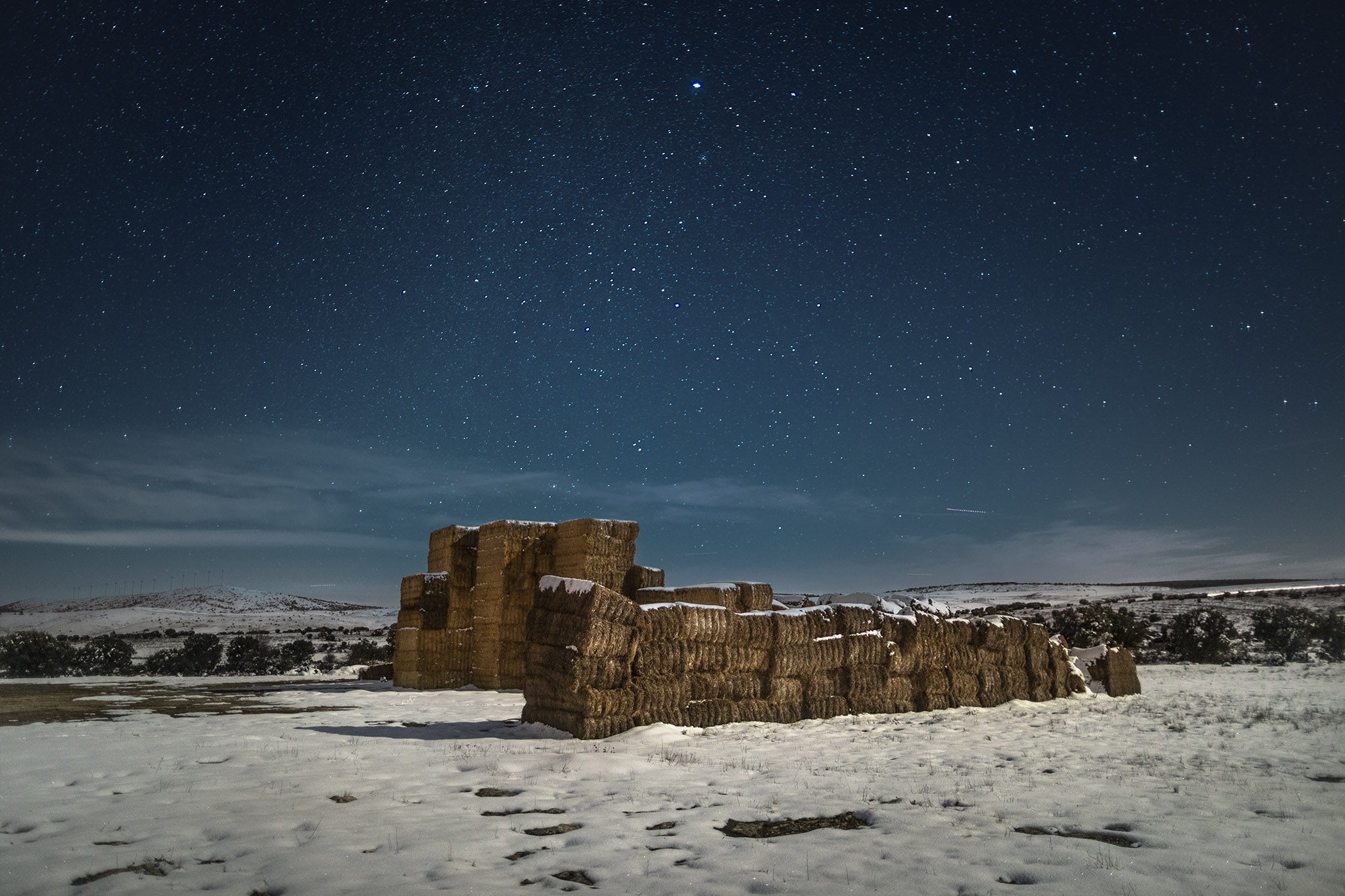
Hay bales stacked in a field near the town of Calderuela, in the province of Soria. © Santi Palacios for Sonda Internacional
The Serranía Celtibérica has reached this situation only after a decades-long migratory process.
A rural exodus extended throughout the 20th century, but up until the end of the 1950s, families were sufficiently numerous and prolific enough to compensate the individuals who emigrated, explains Pascual Rubio. This allowed the population to remain reasonably stable or with slight decreases. At the beginning of the 1960s, two fundamental and interrelated processes began in Spain: industrialization and urbanization. Spanish industry was concentrated in the cities, raising the demand for labor in urban environments. And added to this was a process of agricultural mechanization which reduced the demand for labor in the countryside.

A grave marker still standing within the Santolea cemetary, in Maestrazgo (Teruel). This village was expropriated in 1970 for the creation of the reservoir and dam which bear its name, and which remain standing today. © Santi Palacios for Sonda Internacional
The average age in 40% of the Serranía Celtibérica municipalities is over 50 years old. “The worst is yet to come,” says Francisco Burillo. As added to the migratory process is the decrease of population due to the deaths of older people who still live in the villages, without generational replacement.
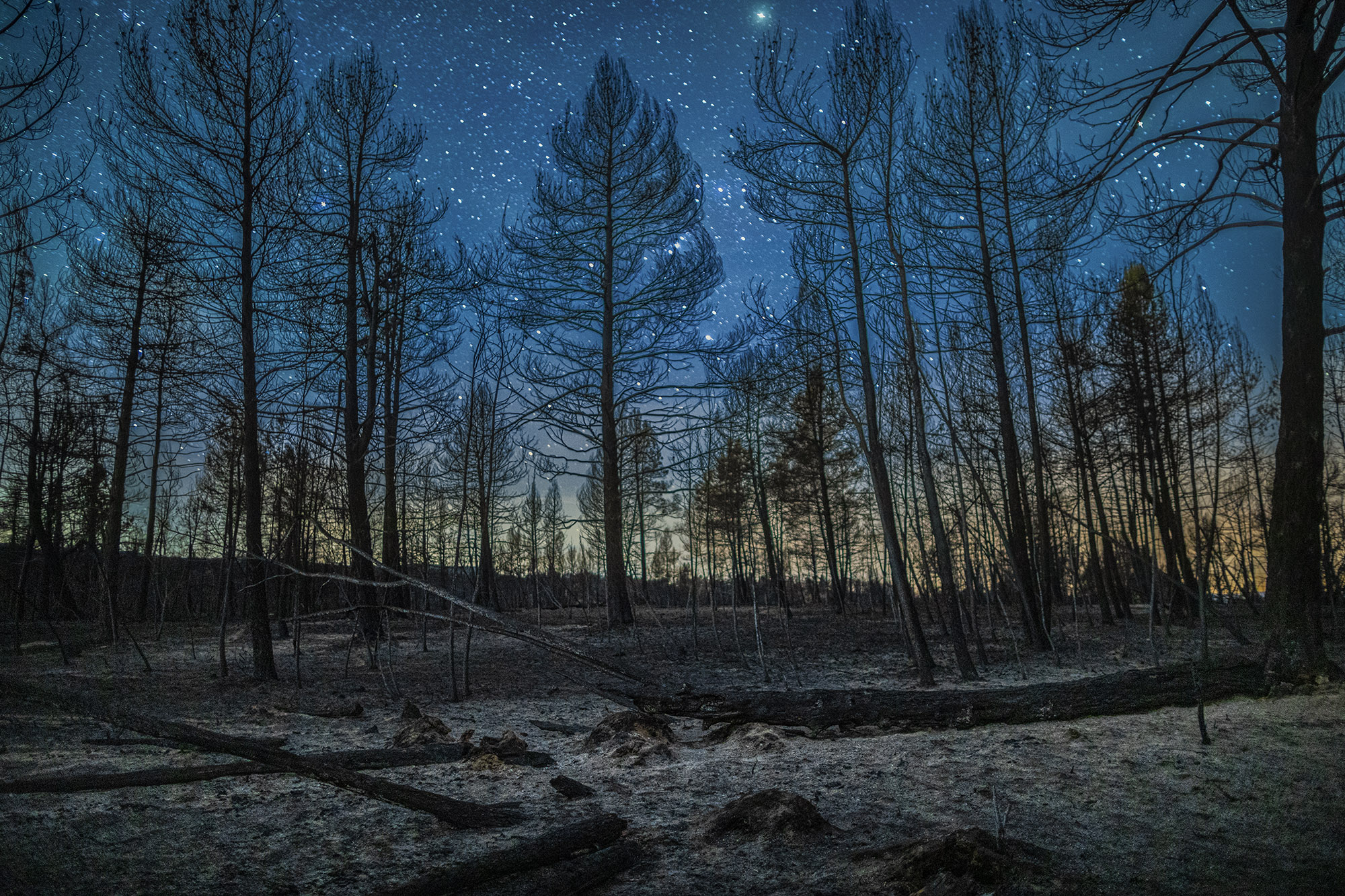
A forest devastated by flames in March on the border between the provinces of Teruel and Castellón, near the municipality of San Agustín. The fire burned about 4,700 hectares. © Santi Palacios for Sonda Internacional
There are three elements needed for a fire to start: activation energy (the spark that starts the fire), oxygen and fuel. The first two cannot be controlled: there will always be oxygen and a spark can always jump, either due to natural causes —lightning— or by human behavior —negligence, accidents or intentional lighting—. This reduces the capacity of action to the third element: fuel or forest mass. Forest management thus becomes the crucial factor in fire prevention.
Once ignited, the behavior of a forest fire is also influenced by three factors, explains Mónica Parrilla, head of Greenpeace’s Forests campaign: topography, meteorology and, again, fuel. “The lack of dynamization of the rural environment due to a lack of institutional support has led to an increase in the forest area as a result of abandonment,” says Parrilla. What evolves is “an increase in the forest area that is highly vulnerable to fire.”
La Toba Reservoir, in the Serranía de Cuenca Natural Park. © Santi Palacios for Sonda Internacional
‘Light pollution: artificial light that shines where it is neither wanted nor needed.’
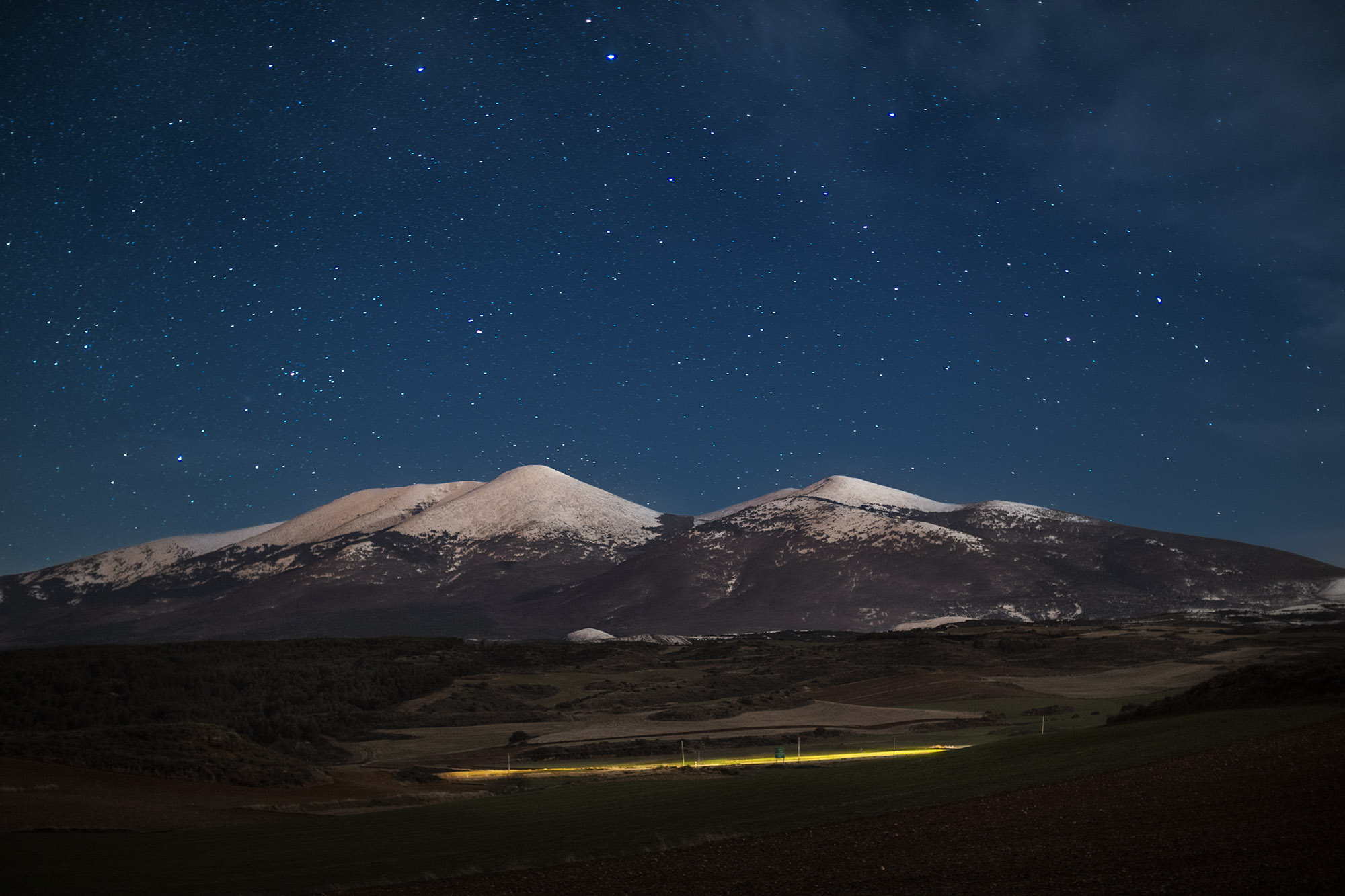
The territory of the Serranía Celtibérica largely affects the Iberian System mountain range. In the image we see the trail of light left by cars as they pass by the sign marking the boundary between the provinces of Soria and Zaragoza, with the Moncayo in the background, the highest peak of this mountain range.
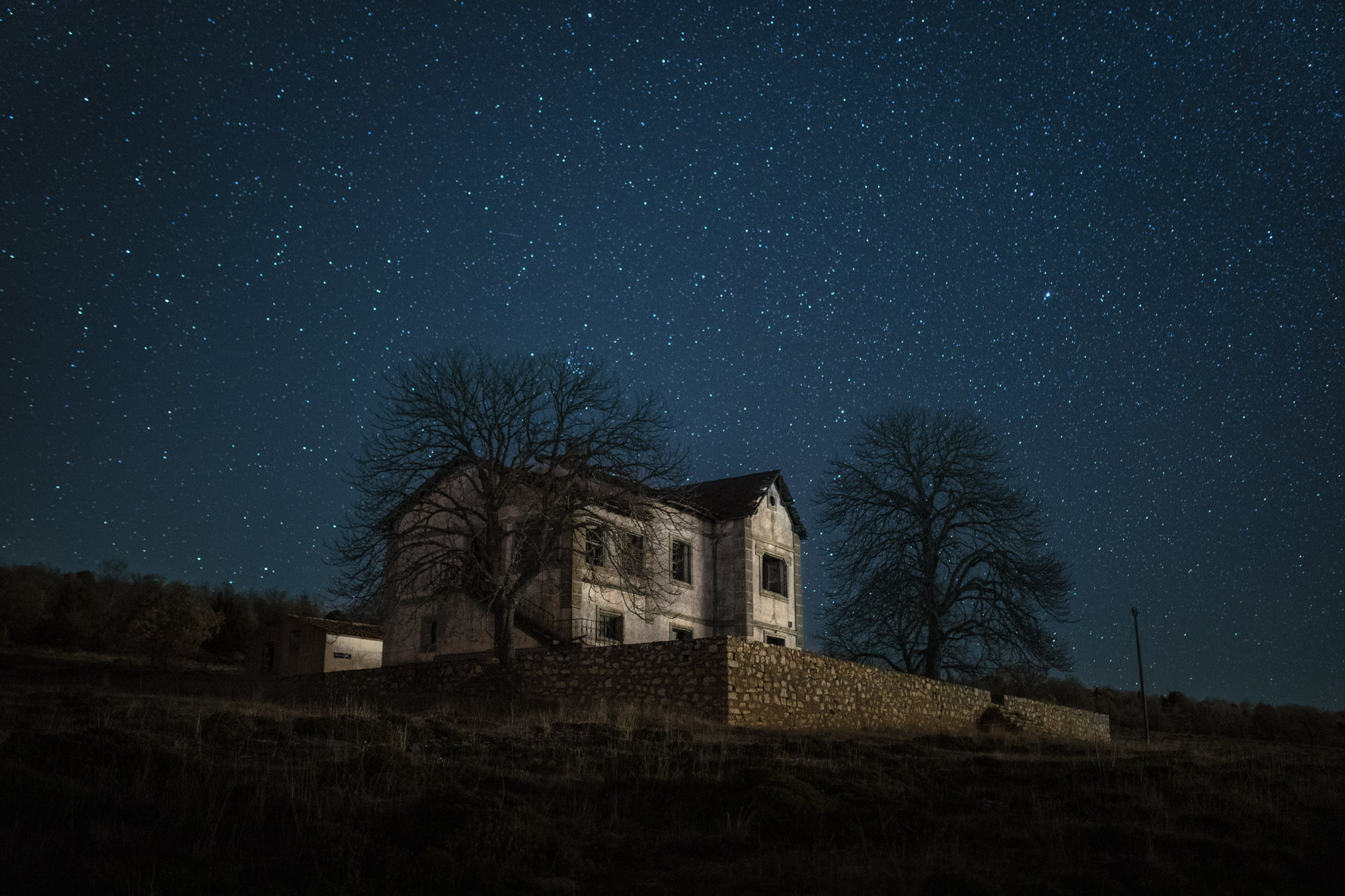
An abandoned house once used by forest rangers in the municipality of Selas, in the Guadalajara province.
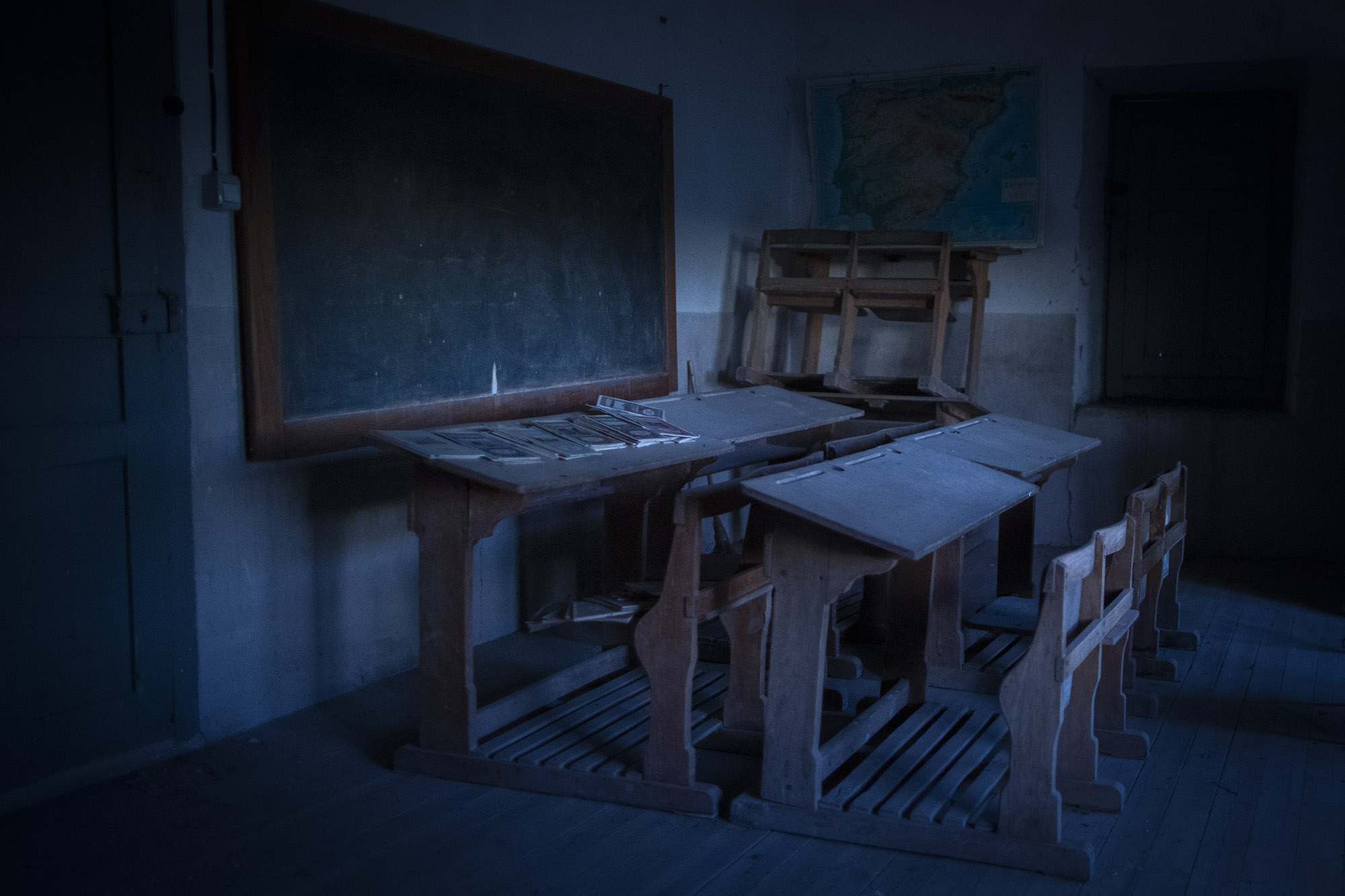
This school in the village of Castilnuevo, in Guadalajara, fell into disuse in the early 1960s.
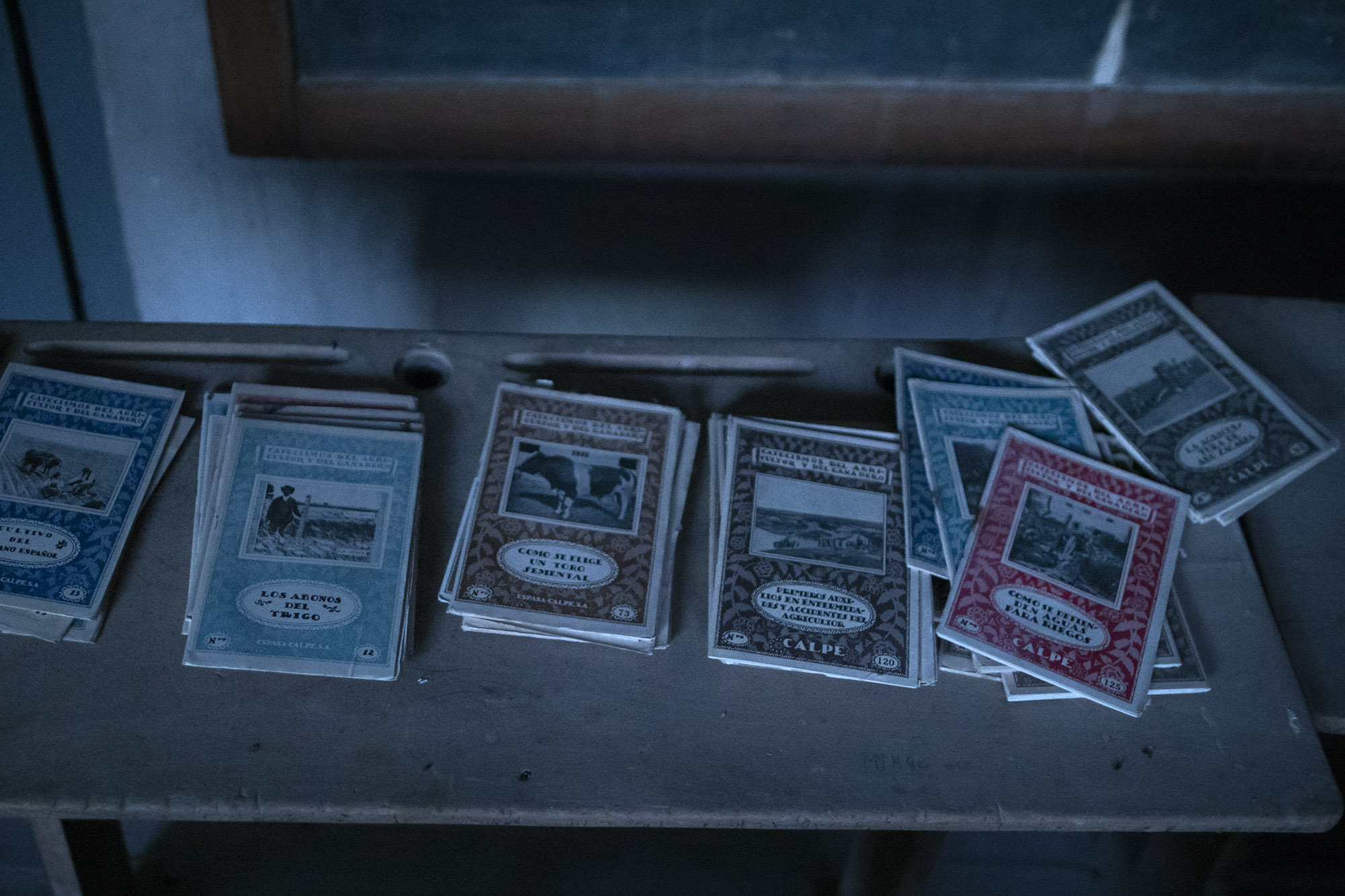
Notebooks published in the 1920s and 1930s left abandoned in the old school of Castilnuevo.
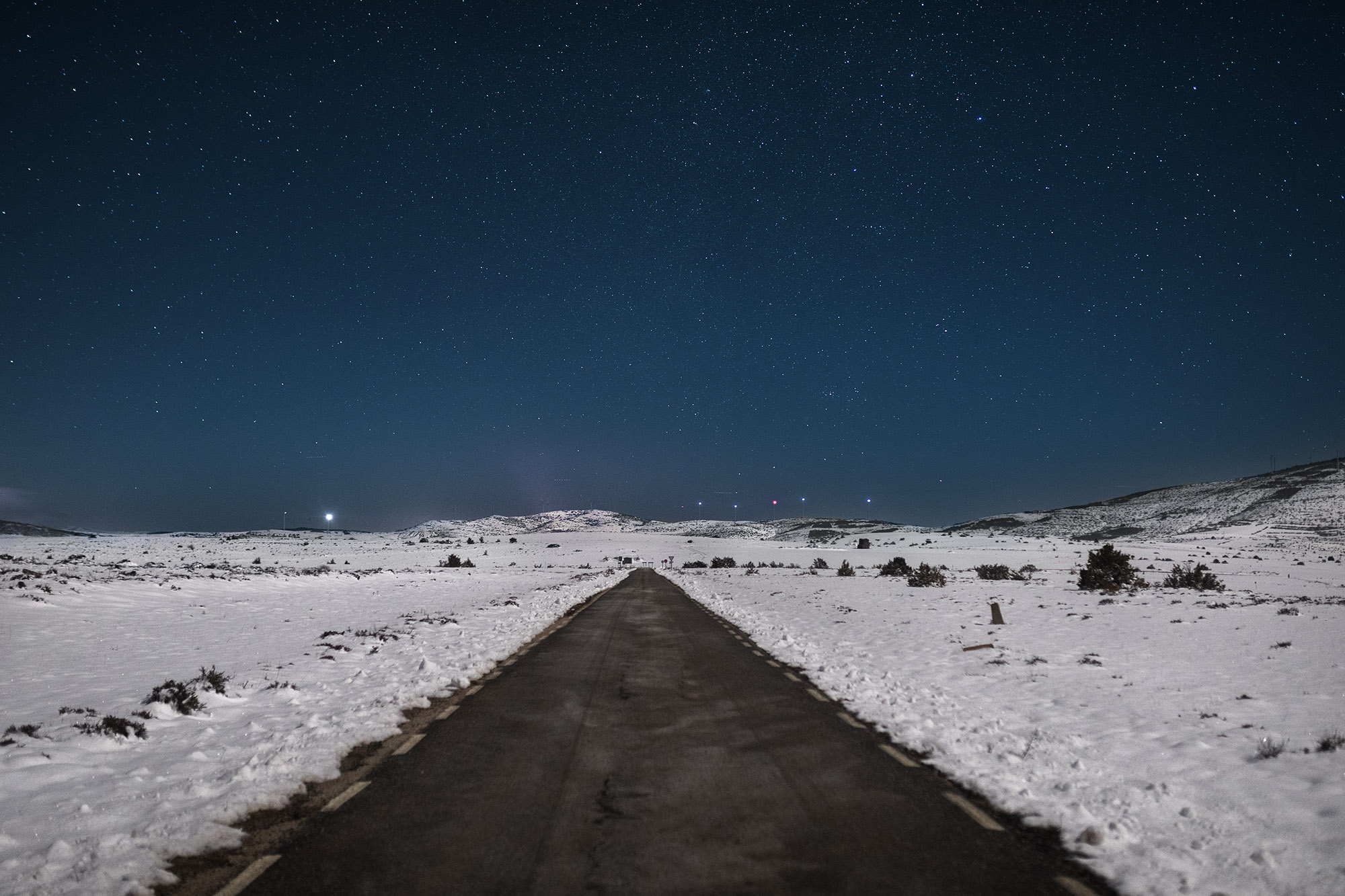
Region of Tierras Altas, province of the Soria. © Santi Palacios for Sonda Internacional

Santiuste Castle, in the Guadalajara province. © Santi Palacios for Sonda Internacional
Areas with extreme depopulation are "terminally ill and need to urgently apply the measures legislated by the European Union for disadvantaged areas," says Francisco Burillo.
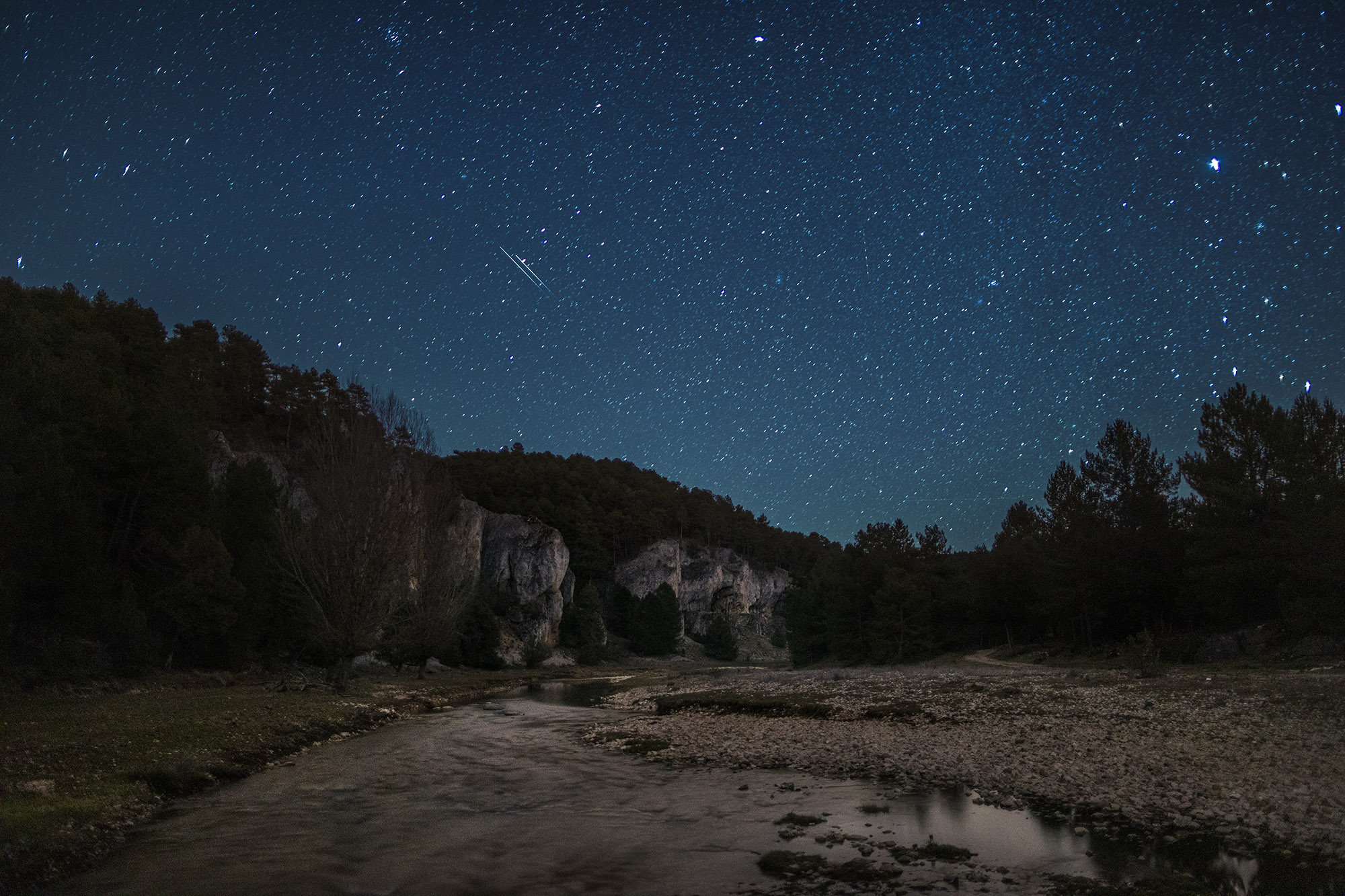
Cañón del Río Lobos Natural Park, in the province of Soria, close by the border of the Burgos province. © Santi Palacios for Sonda Internacional
The province of Soria, one of the epicenters of depopulation, is considered a benchmark in Spain in terms of forest management: the so-called Soria Model is a sample of that relevant nuance that differentiates "depopulation" and "lack of management", says Pablo Sabín, general director of the Cesefor foundation. In the last twenty years, the province of Soria has only suffered two major forest fires.
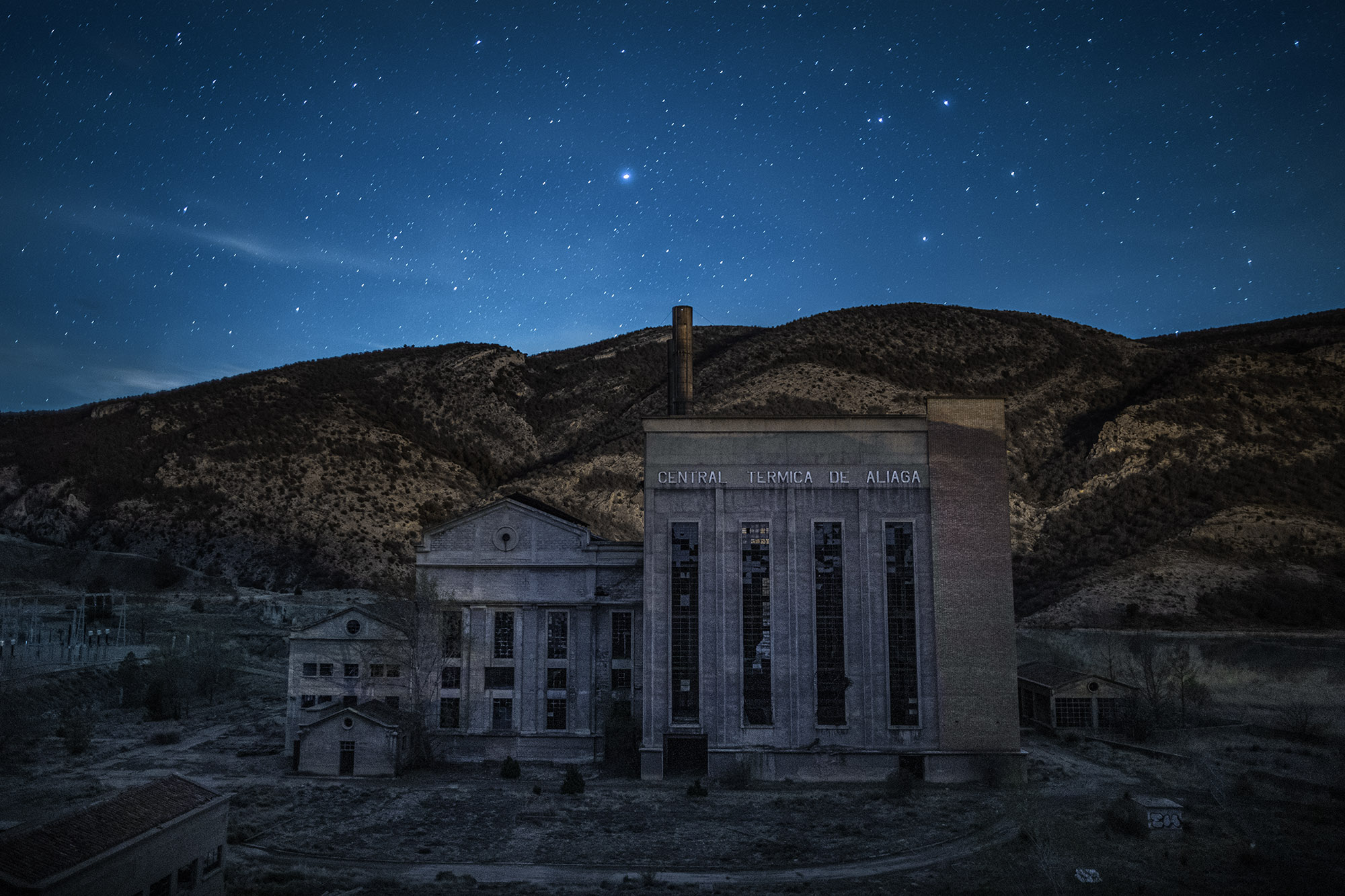
The Aliaga thermal power plant, in the Cuencas Mineras, province of Teruel. This thermoelectric plant was active from the 1950s until 1982, when it closed its doors due to a lack of profitability. The activity it generated during three decades multiplied the population of Aliaga: the peak was reached in 1960, when the village recorded 2,500 inhabitants. At present, 323 people are registered in the village.
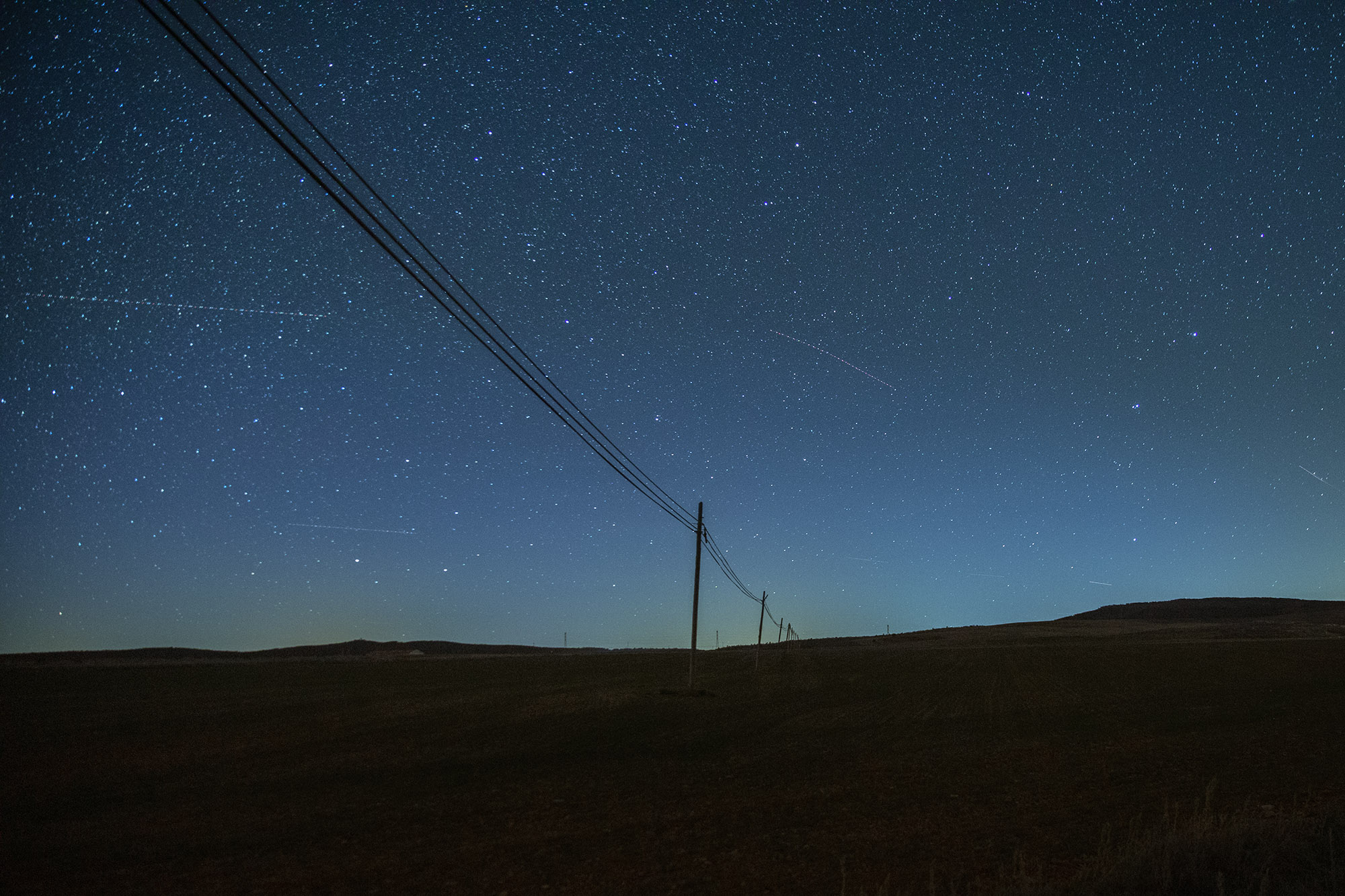
Cultivated fields in the province of Guadalajara, near the border with of Teruel. © Santi Palacios for Sonda Internacional
Agriculture, increasingly extensive and mechanized, is still one of the main economic activities in the region. "Climate change, with rising temperatures and dryness, is another factor that joins the current circumstances that increase depopulation," explains Francisco Burillo.
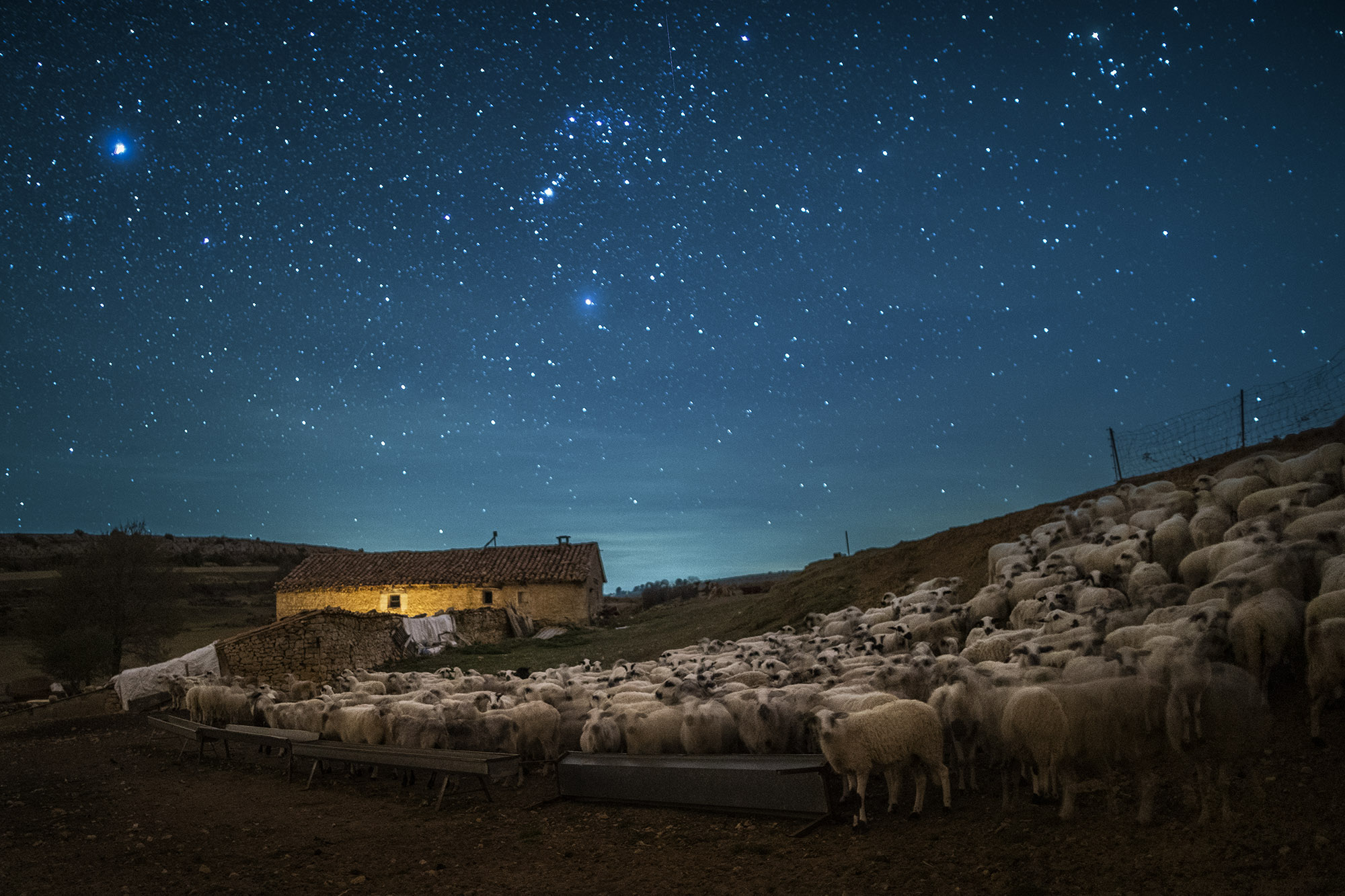
In the image: a flock of sheep in Puerto de San Cristobal, 1,400 meters above sea level, in Maestrazgo, Teruel province. A Templar cross and the year 1622 are marked in stone above the entrance to the house.
The livestock sector is evolving in the face of the enormous difficulties faced by small landowners to make their activity profitable and due to the rise of intensive farming. In spite of this, livestock continues to be, together with agriculture, one of the main economic activities in the Serranía Celtibérica.
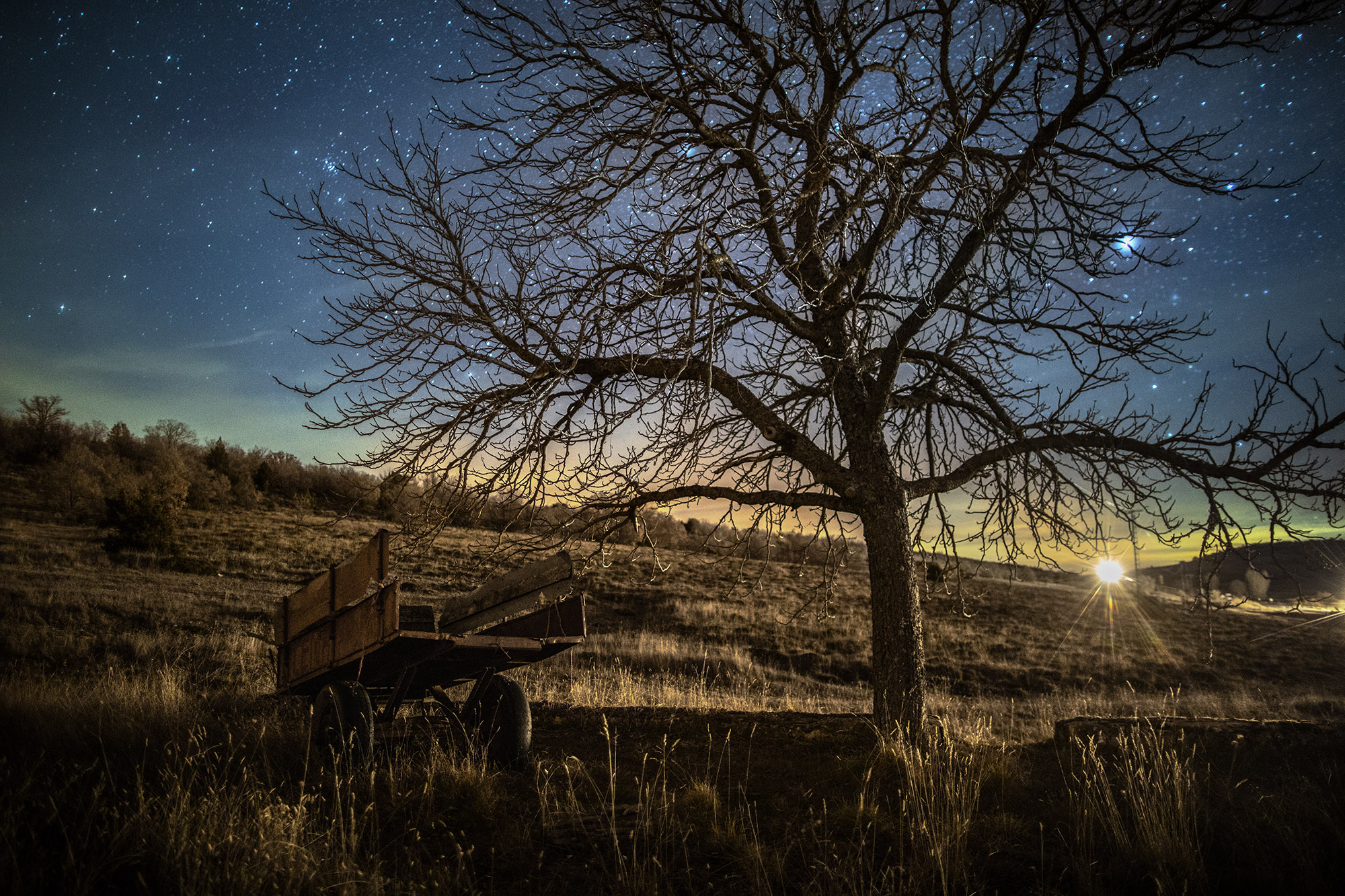
Municipality of Selas, in the province of Guadalajara. © Santi Palacios for Sonda Internacional
Population density can be a tricky indicator. The average for the Serranía Celtibérica is 6.99 inhabitants per km2 (2019). Only four municipalities in this region exceed 20,000 inhabitants: Calatayud, Cuenca, Soria and Teruel. At the same time, other areas suffer some of the most extreme depopulation rates in Europe, such as the region of Tierras Altas (Soria), with about 2 inhabitants per km2, or the Montes Universales (Teruel), where it does not reach 1 inhabitant per km2.
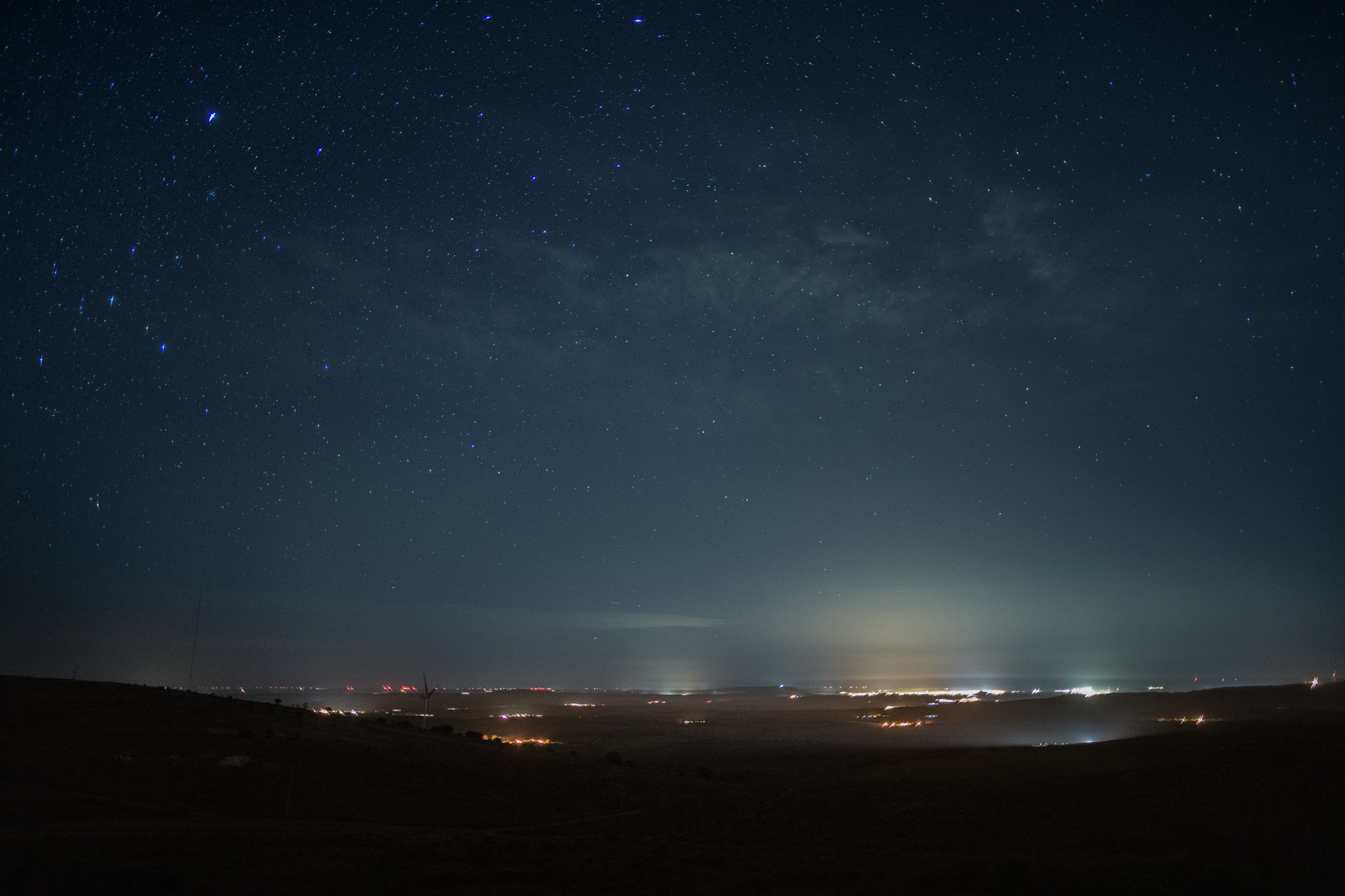
The city of Soria and nearby municipalities as seen from the region of Tierras Altas. © Santi Palacios for Sonda Internacional
Credits
Photography and text: Santi Palacios | Editor: Maribel Izcue | Colorist: Joan Roig | Map: Jorge Mileto | Translation Spanish-English: Lily Mayers
Production costs
The author has made twelve trips between January 2022 and April 2023 through the territory of the Serranía Celtibérica to carry out this work. There have been 55 days of work in the field, not including editing.
The production of this photographic essay has entailed costs of approximately 5,500 euros for transportation, food, lodging and work material, which have been paid by the author.
Sonda Internacional is a non-profit media, founded and managed by a small group of journalists. We created this media as a non-profit organization because years of experience in this profession have proved to us that in-depth journalism is a public service valued by a large part of the population, but it is not a profitable business. Sonda tries to sustain itself with donations from members who believe in the importance of journalism and the climate crisis. We need you to make it happen. You can become a monthly or annual member (or make a one-time donation) here.
Mega Fires: Beyond Extinction
This photo essay is part of the Mega Fires: Beyond Extinction project, a long term work that is only possible thanks to the collaboration of experts and, above all, the community of members who support us to make visual journalism on the climate crisis.
The project is already underway, but we need help to complete it.
Are you interested in journalism and the climate crisis?
You can become a monthly or annual member (or make a one-time donation) here.


